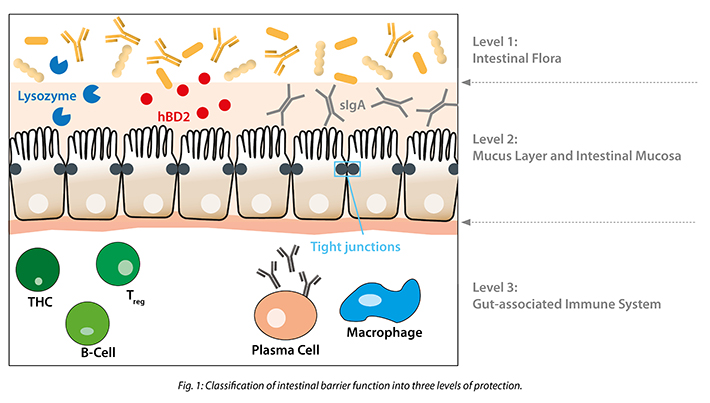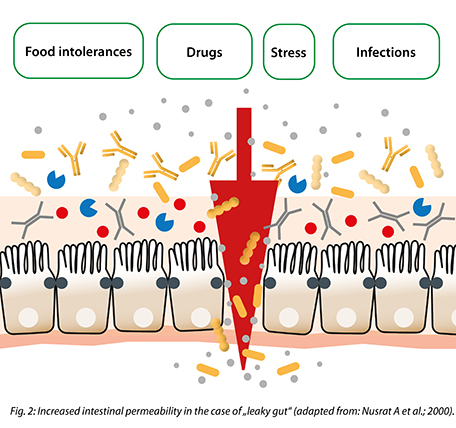


The human intestine, with its length of approx. 8 - 9 meters and surface area of approx. 200 m², is the largest interface between the external and internal environment. An important component of the intestine is the intestinal epithelium, a single-layered cell structure. Its main functions are secretion and absorption. Secretion is the production of digestive enzymes, such as maltases or saccharases, or mucus and its release into the intestinal lumen. Absorption is the uptake of food components into the bloodstream. In addition to secretion and absorption, the barrier function is an essential task of the intestinal epithelium, which ensures a highly regulated permeability.
The intestinal barrier function can be divided into three main levels of protection:

In the case of a disrupted intestinal barrier, the permeability of the epithelium increases which is referred to as "leaky gut". This can be caused by a wide variety of triggers. For example, the intake of certain medications (e.g. antibiotics), intestinal exposure to toxic metals, or even infections can promote a leaky gut. Similarly, there is a link between alcohol consumption, food intolerances or stress with the occurrence of a leaky gut.
Due to an increased permeability of the intestine, food components, commensal or pathogenic microorganisms or even toxins can enter the bloodstream, which can cause systemic inflammation. Typical symptoms in this context are persistent diarrhea and flatulence, general irritable bowel symptoms, food allergies and intolerances. However, more intestinal atypical symptoms such as fatigue and listlessness can also be an indication of a leaky gut. There are numerous scientific publications that link a leaky gut to the development of secondary diseases, such as chronic inflammation or autoimmune diseases.

Due to the varying expression of symptoms, a diagnosis with leaky gut is often a lengthy affair for patients. Immundiagnostik AG offers a broad portfolio of scientifically based biomarkers that can be investigated in the context of a leaky gut diagnosis.
Learn more in our next blog post (part 2) about the diagnostic possibilities in the context of leaky gut.
References:
・ Camilleri, M. (2019). Leaky gut: mechanisms, measurement and clinical implications in humans. Gut, 68(8), 1516-1526. https://doi.org/10.1136/gutjnl-2019-318427
・ Fasano, A. (2020). All disease begins in the (leaky) gut: role of zonulin-mediated gut permeability in the pathogenesis of some chronic inflammatory diseases. F1000Res, 9. https://doi.org/10.12688/f1000research.20510.1
・ Vanuytsel, T., Tack, J., & Farre, R. (2021). The Role of Intestinal Permeability in Gastrointestinal Disorders and Current Methods of Evaluation. Front Nutr, 8, 717925. https://doi.org/10.3389/fnut.2021.717925
・ Nusrat, A., Turner, J. R., & Madara, J. L. (2000). Molecular physiology and pathophysiology of tight junctions. IV. Regulation of tight junctions by extracellular stimuli: nutrients, cytokines, and immune cells. American journal of physiology. Gastrointestinal and liver physiology, 279(5), G851–G857. https://doi.org/10.1152/ajpgi.2000.279.5.G851